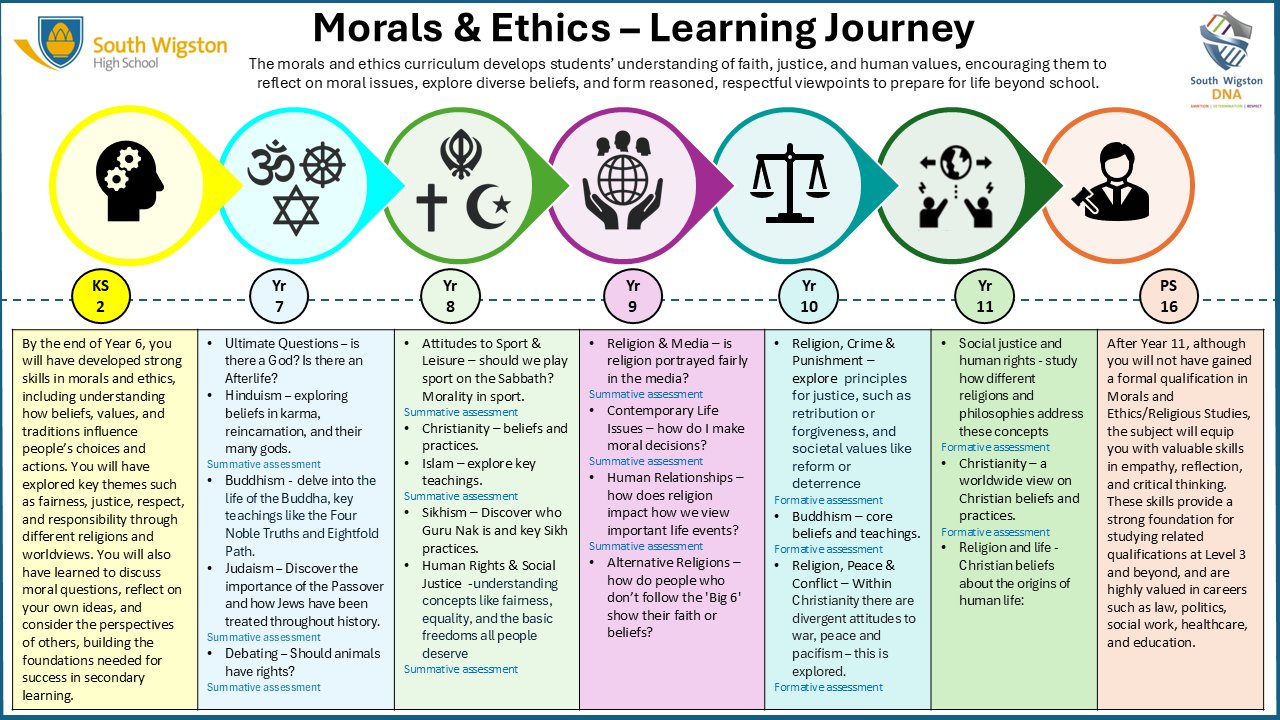Morals & Ethics
Member of staff
Mrs N. Franklin: Curriculum Lead Geography/Morals and Ethics
Mrs L. Armitage: Teacher of Humanities
Mrs D. Katib: Teacher of Morals and Ethics/Health and Social Care
Intent
At South Wigston High School, our Morals and Ethics curriculum is designed to nurture learners into thoughtful, principled, and respectful individuals. Rooted in our school values of Ambition, Determination, and Respect, the curriculum aims to connect their real-world experience with the big questions of today. As they move through the curriculum they will learn about religious and worldviews and approaches that are different to their own. This is powerful knowledge as it helps them to formulate their own views and to understand why some people do what they do because of their beliefs, whether religious or not.
Literacy skills are embedded within the Morals and Ethics curriculum; the use of tier three language is modelled by staff and learners and an integral part of Morals and Ethics lessons. Learners are given opportunities to develop their reading as well as extended writing. Morals and Ethics will also develop learners’ oracy skills as it allows them to discuss what they are learning and to voice their own opinions.
Implementation
The curriculum is delivered through a combination of Religious Education, PSHE, and cross-curricular themes, ensuring a holistic approach. Key features include:
- Ambition: Learners are challenged to explore philosophical and ethical questions, developing their ability to articulate and defend their views with confidence.
- Determination: Through structured debates, case studies, and reflective tasks, learners build resilience in grappling with moral dilemmas and diverse perspectives.
- Respect: Lessons foster a safe and inclusive environment where all beliefs are valued, and learners learn to listen actively and respond thoughtfully.
Morals and Ethics is taught through a sequenced and inclusive programme of study that develops learners’ skills in four key learning foci (LFs):
- LF1: Demonstrate knowledge of religious and ethical beliefs
- LF2: Interpret and analyse moral and philosophical questions
- LF3: Explain different viewpoints and arguments
- LF4: Express personal responses and justify viewpoints
At both KS3 and KS4 learners will develop the following skills.
- Ethical reasoning, understanding different worldviews
- Empathy and respect for diverse beliefs
- Analytical thinking through comparing religious practices
- Debating and evaluating moral dilemmas
- Applying ethical frameworks to real-world issues
Impact
By the end of their journey at South Wigston High School, learners will:
- Demonstrate a well-rounded understanding of moral and ethical frameworks.
- Show confidence in expressing their values while respecting others'.
- Apply ethical reasoning in real-life situations, contributing positively to their communities.
- Embody the school’s values in their daily interactions and future aspirations.
Key Stage 3 Progress Statements
ks3 morals ethics progress statements .pdf
Your Morals and Ethics Learning Journey through South Wigston








 ↑
↑

